Our website is made possible by displaying online advertisements to our visitors.
Please consider supporting us by disabling your ad blocker.
Duty cycle

A duty cycle or power cycle is the fraction of one period in which a signal or system is active.[1][2][3] Duty cycle is commonly expressed as a percentage or a ratio. A period is the time it takes for a signal to complete an on-and-off cycle. As a formula, a duty cycle (%) may be expressed as:
Equally, a duty cycle (ratio) may be expressed as:
where is the duty cycle, is the pulse width (pulse active time), and is the total period of the signal. Thus, a 60% duty cycle means the signal is on 60% of the time but off 40% of the time. The "on time" for a 60% duty cycle could be a fraction of a second, a day, or even a week, depending on the length of the period.
Duty cycles can be used to describe the percent time of an active signal in an electrical device such as the power switch in a switching power supply or the firing of action potentials by a living system such as a neuron.[4][5]
Some publications use as the symbol for duty cycle.[6]
As a ratio, duty cycle is unitless and may be given as decimal fraction and percentage alike.
An alternative term in use is duty factor.[7][8][9]
- ^ Barrett, Steven Frank; Pack, Daniel J. (2006). "Timing subsystem". Microcontrollers Fundamentals for Engineers and Scientists. Morgan and Claypool Publishers. pp. 51–64. ISBN 1-598-29058-4.
- ^ a b Cox, James F.; Chartrand, Leo (June 26, 2001). "Nonsinusoidal oscillators". Fundamentals of Linear Electronics: Integrated and Discrete (2 ed.). Cengage Learning. pp. 511–584. ISBN 0-766-83018-7.
- ^ "Definition: duty cycle". Federal Standard 1037C, "Telecommunications: Glossary of Telecommunication Terms". Boulder, Colorado: Institute for Telecommunication Sciences. 1996. Retrieved March 3, 2011.
- ^ Brown, Martin (1990). "How a switching power supply works". Practical Switching Power Supply Design (Motorola Series in Solid State Electronics). San Diego, CA: Academic Press. pp. 5–8. ISBN 0-121-37030-5.
- ^ Harris-Warrick, Ronald; Nagy, Frédéric; Nusbaum, Michael (1992). Harris-Warrick, Ronald; Marder, Eve; Silverston, Alan; et al. (eds.). Dynamic biological networks: the stomatogastric nervous system. Massachusetts: MIT Press. pp. 87–139. ISBN 0-262-08214-4.
- ^ Singh, M. D. (2008-07-07). Power Electronics. Tata McGraw-Hill Education. ISBN 9780070583894.
- ^ Rudolf F. Graf (1999). Modern Dictionary of Electronics. Elsevier Science. p. 225. ISBN 978-0-08-051198-6.
- ^ "EN 60469:2013". standards.cencenelec.eu. Retrieved 2023-10-14.
- ^ "IEC 60469:2013". webstore.iec.ch. Retrieved 2023-10-14.
Previous Page Next Page








